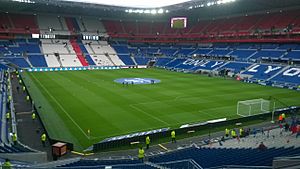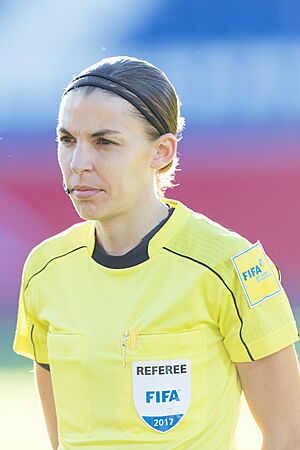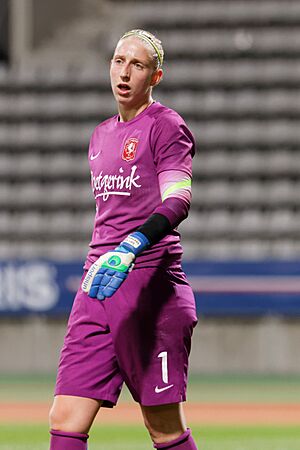2019 FIFA Women's World Cup final facts for kids
| FIFA Women's World Cup 2019 Final - US team on podium (4).jpg
The U.S. team lifts the World Cup trophy
|
|||||||
| Event | 2019 FIFA Women's World Cup | ||||||
|---|---|---|---|---|---|---|---|
|
|||||||
| Date | 7 July 2019 | ||||||
| Venue | Parc Olympique Lyonnais, Décines-Charpieu | ||||||
| Referee | Stéphanie Frappart (France) | ||||||
| Attendance | 57,900 | ||||||
| Weather | Partly cloudy 30 °C (86 °F) 41% humidity |
||||||
|
← 2015
2023 →
|
|||||||
The 2019 FIFA Women's World Cup final was a big soccer match. It decided who would win the 2019 FIFA Women's World Cup. This was the eighth final of the FIFA Women's World Cup, a tournament held every four years. National teams from around the world compete in it. The game took place on July 7, 2019, at the Parc Olympique Lyonnais stadium in Décines-Charpieu, near Lyon, France.
The final was played between the United States and the Netherlands. The U.S. team was the defending champion. The Netherlands team was playing in their first-ever World Cup final. The United States won the match 2–0. This made them champions for the second time in a row and their fourth time overall. Megan Rapinoe scored a penalty kick, and Rose Lavelle scored another goal in the second half. With this win, the U.S. became the second team to win two World Cup titles in a row. Their coach, Jill Ellis, was the first coach to win two Women's World Cup titles.
Both teams were also champions of their own regions. The U.S. had won the 2018 CONCACAF Women's Championship. The Netherlands had won the UEFA Women's Euro 2017.
Contents
The Stadium: Parc Olympique Lyonnais
The final match was held at the Parc Olympique Lyonnais stadium. It is located in Décines-Charpieu, a town near Lyon, France. FIFA called the stadium the Stade de Lyon during the tournament. It can hold 57,900 people. This stadium also hosted both semi-final matches of the tournament.
The stadium was chosen for the final in 2015 when France was picked to host the World Cup. It officially became the venue for the semi-finals and final in September 2017. The Parc Olympique Lyonnais is the home stadium for the Ligue 1 club Lyon. It opened in January 2016. The stadium has also hosted many UEFA Women's Champions League games for the women's team, which is very successful.
Building the stadium started in 2013 and finished in 2015. It cost about €450 million. The stadium also hosted games for UEFA Euro 2016. It will host matches for the 2023 Rugby World Cup and the 2024 Summer Olympics football tournaments.
Before the Match
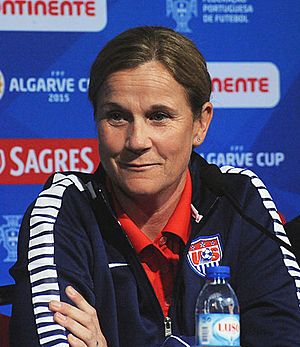
This final was special because it was the first time since 2007 that a European team was in the final. Seven out of eight teams in the quarter-finals were from Europe. The last two finals were between Japan and the United States. This match was the first final since 1991 to have a North American team play against a European team. It was also the first World Cup final for women or men where the defending champions played against the current European champions.
The United States was playing in their fifth Women's World Cup final, which is a record. They were the defending champions and had won the tournament three times before. They won the first-ever final in 1991. They won their second title at home in 1999. In 2011, they lost to Japan in the final. But they won their third title in 2015 against Japan. The U.S. team has always finished in the top three in all eight World Cups. This was their third final in a row, which is also a record.
Jill Ellis became the third coach to reach two Women's World Cup finals. The Netherlands team was playing in their first Women's World Cup final. This was only their second time in the tournament. They were the fourth European country to reach the final. In their first World Cup in 2015, they lost in the Round of 16.
This was the eighth time the United States and the Netherlands had played each other. But it was their first official match. All their previous games were friendly matches.
How They Got to the Final
| United States | Round | Netherlands | ||||||||||||||||||||||||||||||||||||||||||
|---|---|---|---|---|---|---|---|---|---|---|---|---|---|---|---|---|---|---|---|---|---|---|---|---|---|---|---|---|---|---|---|---|---|---|---|---|---|---|---|---|---|---|---|---|
| Opponents | Result | Group stage | Opponents | Result | ||||||||||||||||||||||||||||||||||||||||
| 13–0 | Match 1 | 1–0 | ||||||||||||||||||||||||||||||||||||||||||
| 3–0 | Match 2 | 3–1 | ||||||||||||||||||||||||||||||||||||||||||
| 2–0 | Match 3 | 2–1 | ||||||||||||||||||||||||||||||||||||||||||
Group F winners
Source: FIFA
|
Final standings | Group E winners
Source: FIFA
|
||||||||||||||||||||||||||||||||||||||||||
| Opponents | Result | Knockout stage | Opponents | Result | ||||||||||||||||||||||||||||||||||||||||
| 2–1 | Round of 16 | 2–1 | ||||||||||||||||||||||||||||||||||||||||||
| 2–1 | Quarter-finals | 2–0 | ||||||||||||||||||||||||||||||||||||||||||
| 2–1 | Semi-finals | 1–0 (aet) | ||||||||||||||||||||||||||||||||||||||||||
United States' Journey

The United States is the most successful team in women's soccer. They have won three World Cups and four Olympic gold medals. They have always finished in the top three at every World Cup. Coach Jill Ellis took over the team in 2014. She led them to win the 2015 World Cup. They beat Japan 5–2 in that final. This was their third World Cup title.
The U.S. team was ranked number one in the world before the 2019 tournament. They started their journey with a huge 13–0 win against Thailand. This set a new record for the biggest win in the tournament. Alex Morgan scored five goals in that game. Some people thought their celebrations were too much, but the team and others defended them. The U.S. then beat Chile 3–0 and Sweden 2–0. They won all their group games without letting in any goals.
In the Round of 16, the U.S. played Spain. Captain Megan Rapinoe scored an early penalty kick. Spain quickly scored to make it 1–1. But Rapinoe scored another penalty in the 75th minute, and the U.S. won 2–1. Next, they faced the host country, France, in the quarter-finals. Rapinoe scored two goals, and the U.S. won 2–1, knocking out the hosts.
In the semi-finals, the U.S. played England. Rapinoe was out with an injury, so Christen Press started and scored the first goal. England quickly equalized. Then, Alex Morgan scored to put the U.S. ahead again. England had a goal disallowed by VAR (Video Assistant Referee) for offside. Later, England got a penalty, but U.S. goalkeeper Alyssa Naeher saved it. The U.S. won 2–1. They reached their third final in a row, winning all six matches without ever being behind. They scored 24 goals on their way to the final.
Netherlands' Journey
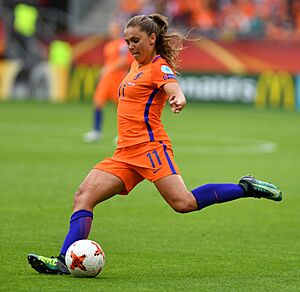
The Netherlands team, known as the Oranje, first played in a major tournament in 2009. They reached the semi-finals of the European Championship. They first qualified for the FIFA Women's World Cup in 2015. Their soccer program has grown quickly because of more investment in professional club leagues. In the 2015 World Cup, they reached the Round of 16 but lost to Japan. The Netherlands then hosted and won the 2017 European Championship. This was their first big international title. They qualified for the 2019 World Cup through play-off games.
The Dutch team was ranked eighth in the world. They were in Group E with Canada, New Zealand, and Cameroon. They won their first match against New Zealand 1–0 with a late goal. They secured their spot in the knockout stage by beating Cameroon 3–1. Vivianne Miedema scored two goals in that game. The Netherlands then beat Canada 2–1 to win their group.
In the Round of 16, the Oranje played Japan again. Lieke Martens scored an early goal for the Netherlands. Japan equalized before half-time. In the last moments of the game, the Dutch got a penalty kick after a VAR review for a handball. Martens scored it, and the Netherlands won 2–1. They then beat Italy 2–0 in the quarter-finals. This win also meant they qualified for the 2020 Olympics.
The Netherlands reached their first Women's World Cup final by beating Sweden 1–0 in extra time in the semi-finals. The game was scoreless for a long time. Jackie Groenen scored the only goal in the 99th minute. The Dutch team reached the final without ever being behind in their six wins. Their success has made women's soccer very popular in the Netherlands. Millions of people watched their games on TV.
Pre-Match Details
Scheduling Conflict
The final was scheduled for July 7. This caused some complaints because two men's soccer finals were also happening on the same day. These were the Copa América final and the CONCACAF Gold Cup final. The Gold Cup final even featured the U.S. men's team. FIFA had set the Women's World Cup dates earlier.
U.S. co-captain Megan Rapinoe called the scheduling "ridiculous and disappointing." A CONCACAF official said it was a "clerical error" and they didn't realize the conflict until it was too late.
Match Ball
The official match ball for the final was called the Adidas Tricolore 19. It was a red version of the Conext 19 ball. The ball's design honored the original Adidas Tricolore ball from the 1998 men's World Cup. France won that tournament at home.
Officials
On July 5, 2019, FIFA announced that French official Stéphanie Frappart would be the referee for the final. Frappart had been a FIFA referee since 2009. She had also refereed at the 2015 Women's World Cup and the 2016 Summer Olympics. In April 2019, she became the first woman to referee a game in France's top men's league, Ligue 1. This was Frappart's fourth match as referee in the tournament.
Manuela Nicolosi from France and Michelle O'Neill from Ireland were the assistant referees. Claudia Umpiérrez from Uruguay was the fourth official. Carlos del Cerro Grande from Spain was the Video Assistant Referee (VAR). This was the first time VAR was used in a Women's World Cup final.
Team News
American co-captain Megan Rapinoe had missed the semi-final due to a hamstring injury. But she said she expected to be ready for the final. U.S. midfielder Rose Lavelle also had a hamstring injury in the semi-final. She also said she was fit to play in the final.
Dutch winger Lieke Martens, who won the Best FIFA Women's Player award in 2017, was also unsure to play because of a toe injury. She started in the semi-final but was substituted at half-time. The Dutch goalkeeper, Sari van Veenendaal, had a swollen hand after the semi-final but was in the starting lineup for the final.
The Match
The United States team played with their usual 4–3–3 formation. Megan Rapinoe, the U.S. captain, was back in the starting lineup after her injury. Lieke Martens also started for the Netherlands. The game kicked off at 5:00 PM in warm weather. There were 57,900 fans in the stadium. Many American and Dutch fans were there. French president Emmanuel Macron and Dutch King Willem-Alexander also watched the game.
The United States attacked early but did not score in the first twelve minutes. This was unusual for them, as they had scored early in all their previous games. Both teams committed fouls. The U.S. kept control of the ball and had many chances to score. Dutch goalkeeper Sari van Veenendaal made several great saves. She stopped shots from Sam Mewis and Alex Morgan before half-time.
In the second half, the game continued to be physical. A U.S. player, Becky Sauerbrunn, got a cut on her face. Later, a Dutch defender, Stefanie van der Gragt, kicked Alex Morgan in the shoulder inside the penalty area. The referee did not call a foul at first. But after a VAR review, the referee awarded a penalty kick to the United States. Megan Rapinoe scored the penalty in the 61st minute. This was her sixth goal of the tournament. It also made her the oldest player to score in a Women's World Cup final.
Eight minutes later, Rose Lavelle scored the second goal for the U.S. She ran through the Dutch defense and shot the ball into the net from about 17 yards.
With the U.S. leading 2–0, the Netherlands tried to attack more. But Sari van Veenendaal still had to make more saves to stop the U.S. from scoring a third goal. The U.S. team celebrated their fourth Women's World Cup title after the match ended.
Match Details
| 7 July 2019 17:00 CEST |
United States |
2–0 | Parc Olympique Lyonnais, Décines-Charpieu Attendance: 57,900 Referee: Stéphanie Frappart (France) |
|
|---|---|---|---|---|
| https://www.fifa.com/tournaments/womens/womensworldcup/france2019/match-center/300438259 |
|
United States
|
Netherlands
|
|
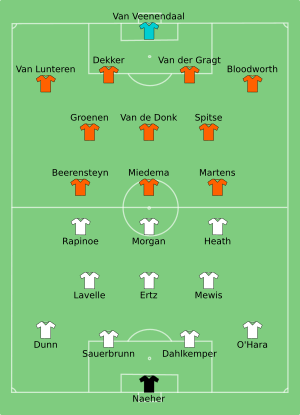 |
|
||||||||||||||||||||||||||||||||||||||||||||||||||||||||||||||||||||||||||||||||||||||||||||||||||||||||||||||||||||||||||||||
|
Player of the Match: Assistant referees: |
Match rules
|
Match Statistics
|
|
|
After the Match
The United States won their fourth World Cup title. They also became the second team to win two World Cups in a row. This win was their first World Cup title won in Europe. During the 2019 tournament, the U.S. scored 26 goals. This set a new record for the most goals in a single Women's World Cup. Their goal difference (goals scored minus goals conceded) of +23 also set a new record. Their unbeaten streak in the World Cup grew to 17 matches. Coach Jill Ellis became the first coach to win two Women's World Cup titles. The team was celebrated with a parade in New York City.
Megan Rapinoe was named the best player of the match. She also won the Golden Ball as the best player of the tournament. She won the Golden Boot as the top scorer with six goals. Alex Morgan also had six goals, but Rapinoe won because she played fewer minutes. At 34 years old, Rapinoe became the oldest player to win these awards. Rose Lavelle won the Bronze Ball award. Dutch goalkeeper Sari van Veenendaal won the Golden Glove award as the best goalkeeper.
Rapinoe was the second player to start in three Women's World Cup finals. Her goal was the first penalty kick scored in a Women's World Cup final that wasn't part of a penalty shootout. She also became the oldest player to score in a final.
The United States team received $4 million in prize money. The Netherlands received $2.6 million as runners-up. Many people, including fans and sports figures, spoke out about the difference in prize money between men's and women's World Cups. They called for "Equal pay!" during the trophy ceremony. A U.S. Senator even proposed a bill to require equal pay for the women's team.
On July 30, 2019, the U.S. Soccer Federation announced that coach Jill Ellis would step down. She would continue to work as an ambassador for U.S. Soccer. The U.S. team was named "Athlete of the Year" by Time magazine. Rapinoe also received several individual awards.
Broadcasting and Viewership
The final match was watched by many people around the world. About 82.18 million people watched it live. A total of 260 million people watched some part of the game. This set a new record for the tournament. In the U.S., the Fox TV broadcast had 14.3 million viewers. This was more than the 2018 men's World Cup final. Another 1.6 million Americans watched the match in Spanish on Telemundo.
In the Netherlands, 5.5 million people watched the final. This was about 88% of people with TV access. In Brazil, 19.9 million people watched, setting a new record for women's soccer there. Many people also watched in France, Germany, Sweden, and the United Kingdom.
See also
 In Spanish: Anexo:Final de la Copa Mundial Femenina de Fútbol de 2019 para niños
In Spanish: Anexo:Final de la Copa Mundial Femenina de Fútbol de 2019 para niños
- Netherlands at the FIFA Women's World Cup
- United States at the FIFA Women's World Cup


